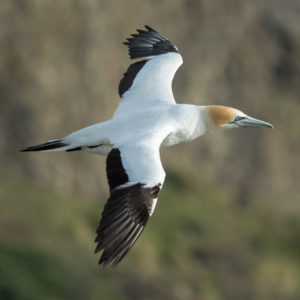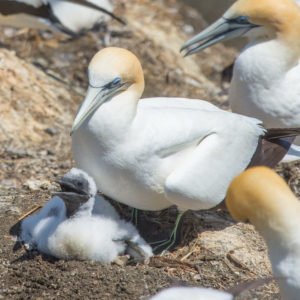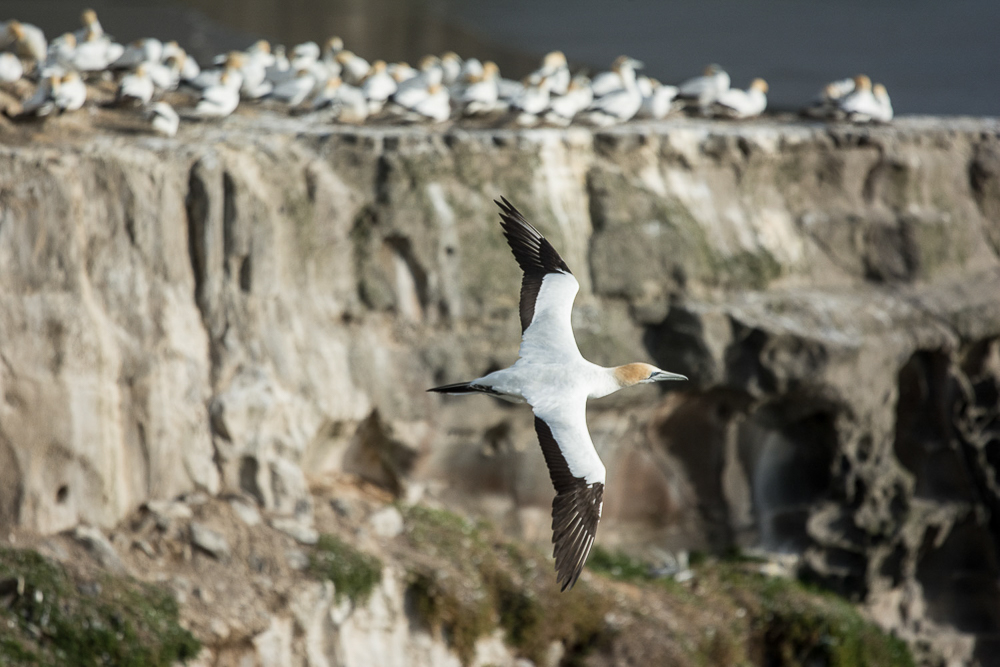The Muriwai Gannet Colony is one of only 3 places in NZ where they nest on the mainland (normally they are nesting on islands). The colony has great viewing areas and some birds nest right next to those making it a great location for birdwatching. We run a Kumeu wine tour over summer which visits them. This page has some information about the colony and these amazing birds.


Some interesting information about gannets
- Wingspan up to 180 cm (6 ft)
- Overall length 90 cm
- A single egg is laid around September/October/November
- Incubation time about 44 days
- Gannets can live to around 30 years old
- Chicks stay in the colony until February/March – they leave when around 4 months old
- The birds then migrate to Australia, returning after 3-7 years
- It is said that (after weeks of furious flapping of wings on land) the first flight of the juvenile birds takes them to their destination more than 2000 km away.
- Gannets feed by diving from high up into a school of fish near the surface of the water at speeds of up to 145kmh. Just before they hit the water, they hold their wings out straight and bend them so they’re pointing completely backwards, so they don’t get damaged when hitting the water at high speed. They also take a gulp of air, which fills air sacs in their neck and chest, providing cushioning just like an airbag in a car.
- The diet of gannets is mainly small fish such as pilchards, anchovy, yellow eyed mullet and baby squid
History of the Muriwai gannet colony
On the island of Oaia off the coast of Muriwai a gannet colony established in the early 1900’s. Since around 1975, birds began nesting on the cliffs of Muriwai due to overcrowding on the island (first on Motutara Island, spilling over to the mainland at Otakamiro Pt (Named after ancestor Takamiro) in 1979 – originally only to the southern point, then also to the northern point, and now spreading further). The colony can be up to around 2,000 birds (out of the 50,000 around NZ). Muriwai is one of only 3 mainland colonies (Cape kidnappers and Farewell spit are the others) but there are around 50 colonies in total.
For a shorter period (October/November to January) the ledges of the cliffs below the gannets are inhabited by white-fronted terns (Tara). These birds are smaller than gannets, flying rather like large swallows. (The terns were in fact displaced from the high ground when the gannets started to colonise Motutara Island and Otakamiro Point.)


Gannet Chicks
A single egg is laid which may be replaced if broken or rolled out of the nest. Both the male and female incubate the egg in turn with the webs of both feet placed over the egg although towards the end of the incubation period of 42–44 days the egg is transferred to the top of the feet. The naked blind and helpless chick is fed by gurgitation by both parents; one guarding the nest while the other is out gathering food.
Migration
Banding of gannet chicks has provided information on the movements of young gannets and on their survival rates. The Australasian gannet migrates westward to the eastern and southern coasts of Australia. Some birds have been recorded as far away as northern Queensland and Freemantle in Western Australia. The perilous journey is taken without parental guidance on the young bird’s first flight but as many as 30 per cent survive.
When the chicks are around 4 months old they fly to Australia (Mainly the southern coastlines). Immature gannets return to New Zealand when 3–7 years of age and breed from 4–7 years of age. With an estimated life span of 25–38 years, gannets are one of the longest living sea birds.


